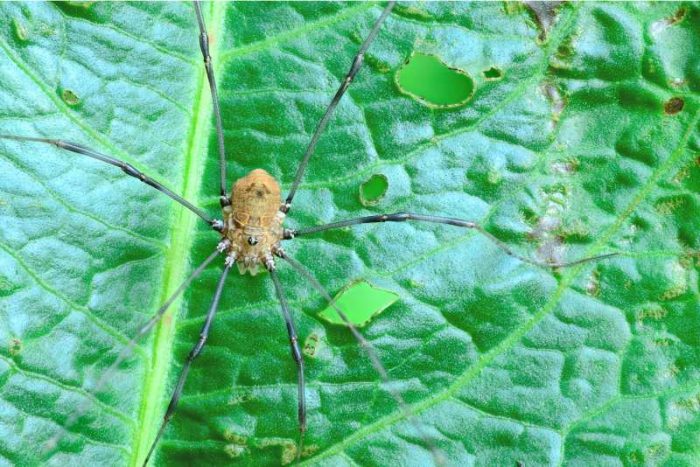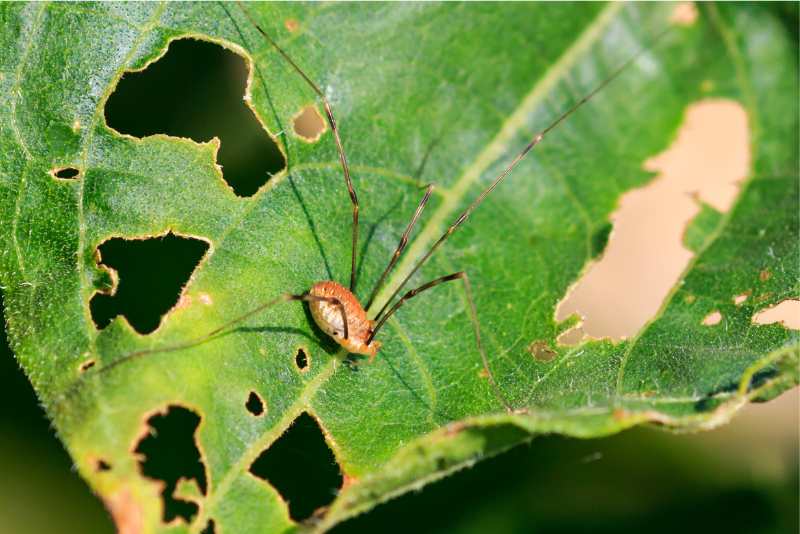Forget about the black widows and brown recluses, there’s a new spider in town, the Bunny Harvestman! If you thought most spiders were creepy, wait until you learn about the bunny Harvestman spider!
In short, this species of spider is an arachnid that looks like a cross between a rabbit and a daddy long leg. That’s right you heard it, a rabbit!
This is because the black nubs on the Harvestman spider are actually designed to resemble the ears of a rabbit, making it appear larger and scarier to predators.
But, despite its spooky appearance, bunny harvestmen are harmless to humans and just another fascinating example of the diversity of life on our planet.
With that said, if you’re looking for more information regarding this species, for example, their autotomy, reproduction, habitat, and a whole lot more, then keep reading!
What Is A Bunny Harvestman Spider?
To start with, what is the bunny harvestman spider? Well, this spider was first described in 1959 by German arachnid specialist Dr. Carl Friedrich Roewer and is one of over 6,500 species under Opiliones.
The Opiliones have five suborders that include: Eupnoi, Dyspnoi, Laniatores, Tetrophthalmi, and Cyphophthalmi.
Their body has a rounded shape and is covered in small, white fur-like setae (hairs) that resemble tiny ears or whiskers.
They have eyes larger than most other spiders, arranged in two rows of four.
People often call the bunny harvestmen “daddy longlegs” because of their long, slender legs, but they should not be confused with the similarly-named spiders.

Another interesting fact is that these spiders are also referred to as arachnids, and phenotypically! They are actually more closely linked to scorpions and camel spiders.
Physical Characteristics
The Bunny Harvestman Spider is a small, relatively slender spider with an oval-shaped body. They have long, thin legs that are two to three times the length of their body, and they move about by walking rather than by jumping.
Their main attraction, is their head, which is shaped like that of a black bunny or dog getting their name. However, unlike most spiders that have eight eyes, the harvestman spider only has two!
The color of these spiders very from dark brown or black, to yellow, and even orange! The females of the species have a lighter, yellowish-colored stripe down the middle of their backs.
Sensing Organs
Bunny Harvestman Spiders have very good senses for detecting predators. They have a pair of eyes that are very sensitive to light and dark, and they can also sense movement with their sensory legs.
These legs are also used for grooming, as the spiders are very clean and pay special attention to their legs.
Autotomy
Bunny Harvestman Spiders have a unique self-defense system called autotomy. If they are caught by a predator, they can shed one or more of their legs to escape.
The lost leg will continue to twitch for a short time, distracting the predator and allowing the spider to flee. The legs will eventually grow back, but it takes a long time and the spider is vulnerable during this period.
Reproduction
Bunny Harvestman Spiders reproduce sexually, with males directly copulating with females. Before copulation, males offer a secretion from their chelicerae to the female as a nuptial gift.
Females have a flexible ovipositor for laying eggs, and the copulation is brief, and minimal courtship is involved.
Most species of harvestmen have separate sexes, but some species are parthenogenetic, meaning they can reproduce asexually.
Behavior
In terms of behavior, Bunny Harvestman Spiders are beneficial to have around as they eat small insects and other arthropods. They are not venomous and pose no threat to humans.
Their autotomy system is an effective defense mechanism, allowing them to escape from predators relatively unharmed.
Habitat
The Bunny Harvestman Spider is found in the Amazon rainforest, particularly in Ecuador. They prefer to live in moist habitats such as leaf litter, under rocks, and in crevices.
They are omnivorous scavengers, feeding on small insects and other invertebrates.
The Bunny Harvestman Spider is not an endangered species, but its habitat is under threat due to deforestation and other human activities.
Andreas Kay, a photographer and naturalist, has been working to raise awareness about the importance of preserving the rainforest and its biodiversity, including the Bunny Harvestman Spider.
Related Post: Do Spiders Have Tongues?
Predators And Prey
Predators
Bunny harvestman spiders have several natural predators, including birds, amphibians, and other arachnids like scorpions and recluse spiders.
These predators hunt and feed on the harvestmen, and their methods of attack vary depending on the predator.
For instance, birds may swoop down and catch the harvestmen in their beaks, while scorpions and spiders may use their venom to immobilize and kill the harvestmen.
Prey
Bunny harvestman spiders are omnivorous and consume a variety of foods. They prefer to devour mostly decaying plant and animal materials instead of pursuing only prey like spiders do.
Additionally, they may eat snails and other tiny invertebrates. Harvestmen are predators and scavengers who consume both living and dead prey that have soft bodies.
They don’t hunt like spiders. Instead, they eat decaying vegetation and animal detritus. Overall, bunny harvestman spiders play an important role in the ecosystem by helping to break down and recycle organic matter.
While they may fall prey to a variety of predators, they also have a diverse diet and are well-adapted to their environment.
Related Post: Do Spiders Come Out At Night?

Venom and Silk
Venom Glands
Bunny harvestman spiders do not have venom glands, which means they are not venomous and do not pose any threat to humans.
This is different from spiders, which have venom glands and can be dangerous to humans.
Silk Glands
Similar to their lack of venom glands, bunny harvestman spiders also lack silk glands. As a result, they do not spin webs like spiders do.
Instead, they rely on their eight legs to move around and their unique appearance to deter predators.
While bunny harvestman spiders do not produce silk, they do have a unique defense mechanism. When disturbed, they emit a strange odor that can deter predators. This odor is produced by scent glands located on their legs.
Ecology and Biodiversity
Bunny harvestman spiders are found in various habitats, including forests, grasslands, and deserts. They are known to be active at night and hide under rocks and logs during the day.
These spiders are omnivorous and feed on insects, mites, small invertebrates, and plant matter. They play a critical role in controlling the population of other invertebrates, making them beneficial to the ecosystem.
Beneficial Role
Bunny harvestman spiders are important members of the ecosystem as they help to control the population of other invertebrates.
They feed on insects, mites, and other small invertebrates, which helps to keep their population in check. This, in turn, helps to maintain the balance of the ecosystem.
Moreover, these spiders also play a crucial role in the decomposition of organic matter. They feed on dead plant matter, which helps to break it down into smaller particles.
This makes it easier for microorganisms to decompose the matter, which further enriches the soil.
Endangered Status
Bunny harvestman spiders are not currently listed as endangered. However, like many other species, they are at risk due to habitat loss and fragmentation.
Human activities such as deforestation, agriculture, and urbanization are major threats to their survival. Climate change is also a concern as it can alter their habitat and disrupt their lifecycle.
It is important to protect the habitats of bunny harvestman spiders and other species to maintain biodiversity and preserve the delicate balance of the ecosystem.
Comparing The Bunny Harvestman To Other Spiders
Cellar Spiders
Cellar spiders, also known as daddy longlegs spiders, are related to harvestmen and share some similar physical characteristics.
They have long, thin legs and walrus-like heads, and are known for their messy tangled webs, which they use to capture small insects.
Long-Legged Sac Spiders
Long-legged sac spiders also have long, thin legs and a similar body shape to harvestman spiders. They are typically brown or tan in color and have two small, forward-facing eyes.
Unlike the Bunny Harvestman, long-legged sac spiders are capable of biting humans, and their venom can cause pain and swelling.
Spiny Orb-Weavers
Spiny orb weavers have long, spiny legs, which are used to help weave their distinctively patterned webs.
They are typically brown or black in color and have a bulbous abdomen. Like the Bunny Harvestman, spiny orb-weavers are harmless to humans and are beneficial predators of insects.
While these spiders all have some similarities to the Bunny Harvestman, they also have distinct differences in their behavior, habitat, and other physical characteristics.
It’s important to appreciate the diversity of the spider world and learn about each species on its own terms.
Conclusion
So now you know what a Bunny Harvestman spider looks like! If you found this article helpful don’t forget we cover a wide range of topics about different species of spiders.
So feel free to do some exploring on this site and see what else you can learn.
Related Post: Do Spiders Really Feel Pain?




Leave a Reply